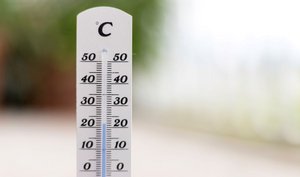Campus operations
Below, you will find examples of sustainable solutions in AU's campus operations. On AU's information website, www.au.dk/kilowhat, you can also read more about the university's efforts to reduce energy consumption.
A cleaner and more environmentally friendly University Park
Challenge
Aarhus University wants to make sure that maintenance of the University Park is sustainable and environmentally friendly. However, in order to support the university’s needs, the technology behind the sustainable solutions the university uses (e.g. various machines and products) must be able to function on a large scale.
Solution
The Parks and Gardens Section at Aarhus University is very concerned about developing a greener campus, and in 2000 they stopped using herbicides to combat weeds – instead they use techniques like heat treatment to clean algae.
In addition, as far as the technology allows, they increasingly use electric machines instead of diesel-powered machines on the university’s grounds for tasks such as sweeping, clearing snow and spreading salt. These solutions help reduce the consumption of fossil fuels and carbon emissions, and they help secure a better work environment for our employees.
A cross-university waste group has also been working on defining a greener waste solution to facilitate waste separation. This initiative will be a major step towards more sustainable waste management. The details of the new waste solution still need to be worked out as AU first has to improve its waste-collection infrastructure.
Result
Less noise and pollution and thus a cleaner and more environmentally friendly University Park. In addition, the environmental impact on the groundwater has been eliminated as no herbicides are used in the park.
Further information
If you have any questions, you are welcome to contact the head of building services at Aarhus BSS, Peter Bachmann Vestergaard.
Creating value through renovation in a holistic perspective - ReVALUE
Challenge
Generally speaking, the challenge is that a large stock of public housing is in need of energy renovation. The operation of these buildings is uneconomical, as they use too much energy and do not encourage social sustainability.
In response to this challenge, the goal of the REVALUE project is to pave the way for world-class energy renovation. Specifically, the project is a study of how we can get the most value for society and sustainability out of the money spent on renovation of public housing.
Solution
The purpose of the project is to use innovative and holistic thinking in relation to future renovation projects, primarily within the area of public housing. The challenge can be solved by working on several fronts. For example, by establishing an innovative national platform that can develop, document and implement solutions for the renovation of buildings. The platform will also be able to draw attention to potentials for sustainability and value creation in a design proposal.
Additional information
Read more on the website www.revalue.dk or in the brochure(in Danish). You are also welcome to contact project manager Søren Wandahl at swa@eng.au.dk.
DGNB certification of buildings with a focus on climate

Challenge
Aarhus University has already taken many steps to reduce resource consumption in the university’s operations, and has made considerable progress. However, the university needs to maintain its focus on improving and developing in this area.
Solution
The university can ensure its continued sustainable development by focusing on finding sustainable solutions when buildings are constructed and renovated on its campuses. Having buildings certified under the voluntary Danish DNGB scheme is one way to achieve this. DGNB is a sustainability certification for buildings which places equal importance on environment, finances and social conditions. The university is also seeking DNGB certification of the entire University City development in Aarhus.
Find out more
News article: Buildings in the University City to get sustainability certification
19 C

Challenge
Aarhus University wants to reduce its carbon emissions in 2025 by 35 per cent compared with the 2018 baseline.
Solution
- Aarhus University will heat its buildings to a maximum of 19 degrees Celsius in the autumn and winter months, in line with the government’s new guidelines.
- Nineteen degrees is not as warm as we’re used to, so some staff may find they need to dress a bit more warmly in the coming months. Previously 21 degrees Celsius was the maximum temperature according to AU guidelines.
- In many buildings, the temperature is regulated centrally. But in some locations, temperature is regulated by the thermostats in the rooms. In such rooms, it’s your responsibility to help make sure that the temperature is kept at 19 degrees Celsius.
- The temperature may vary from room to room – and in fact, the temperature will vary in the same room depending on where you are. It’s coldest next to the window and next to the door, for example.
- This temperature adjustment is an important contribution to reducing AU’s heat consumption. For every degree the temperature is reduced in a building, on average, the university’s heat consumption will fall by a minimum of 3%.
Night-time campus closure
Challenge
Aarhus University wants to reduce its carbon emissions in 2025 by 35 per cent compared with the 2018 baseline.
Solution
AU has identified opportunities to introduce night-time closure of campus – with particular focus on energy-intensive laboratory buildings. Including establishment of a system to keep the campus open at night if required:
In future, there will be more focus on possibilities to close laboratories at weekends and during holidays, and on better control of ventilation at night to reduce energy consumption.
Electricity meters for selected IT equipment
Challenge
Aarhus University wants to reduce its carbon emissions in 2025 by 35 per cent compared with the 2018 baseline.
Solution
AU has completed a pilot project with electricity metres on selected IT devices in order to develop guidelines for default settings for employee PCs, for example use of hyper mode:
An overview has been prepared of the energy consumption of computers provided for employees by AU.